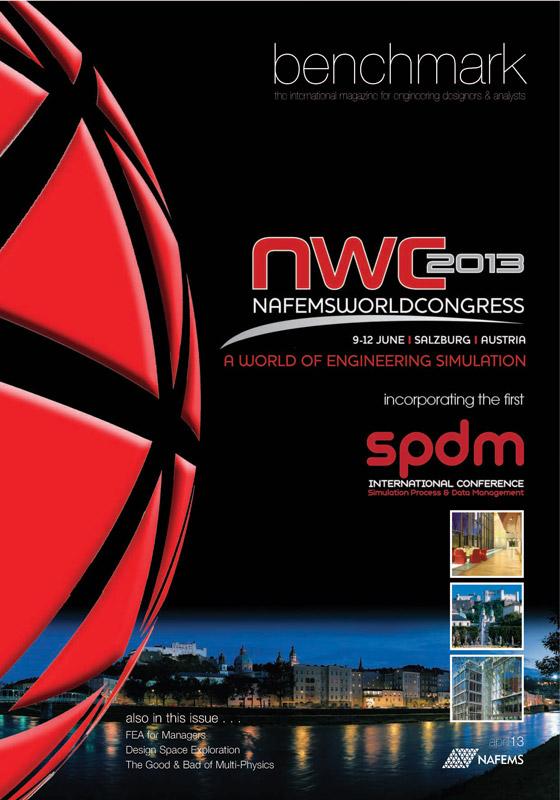In this Issue:
- NAFEMS News
- CAE Guy
- Managing FEA
- NWC13 Preliminary Agenda
- Design Space Exploration
- Does Multiphysics Make Fools of Us All?
Question: do we question enough, or too much? Ok, that sounds like a riddle, but sitting here in a caffeine-fuelled darkened office, tidying-up the loose-ends of this issue in the wee small hours, it makes perfect sense.
Hear me out on this.
There was a time in the not-so-distant past that technology seemed to be the answer to everything. Increased processing power, technical innovation, and downright design genius was going to improve everything under the sun. Cars were (are?) going to drive themselves. Cellphones were (are?) going to respond intuitively to our voices and thoughts. Software was going to get everything right without even a chance of error. Technology, it seemed, was the definitive answer to whatever question we decided to throw at it.
I think it’s gone the opposite way.
Never before have we been able to interact, discuss, ruminate and hypothesise about everything and anything. Our hyper-connected world allows us access to the thoughts and opinions of millions of people we’ve never even met, let alone would trust to make decisions for us. What’s happened is that, in our search for “the answer”, all we’ve done is create a never-ending repository of minds which will cause us to ask more questions the more we think about it. Analysis and simulation have progressed so rapidly that we find ourselves constantly asking “Is that right? How do I know that’s accurate? How can I get even-more correct?” I’m sure that’s not the response that the developers of the technology wanted their products to elicit. They’re striving to be ever-more accurate, to be ever-more “unquestioning”, yet we the users simply ask more questions when they provide more accurate answers.
This issue of benchmark asks questions of varying importance, ranging from “does multi-physics make fools of us all?”, to the more easily answered “is an engineer more dateable when dressed in Prada instead of hand-me-downs?”. And that’s a big part of NAFEMS’ role (not the style-advice part, unfortunately). To question. To allow you a forum to question the products, the technology, the accuracy of results, and the very processes you go through each day in order to carry out your work.That’s why forums such as the NAFEMS World Congress are so important. Yes, there are many presentations that will tell you how a particular problem was solved, using a particular piece of software and methodology, but the beauty of these events is that for every presentation extoling the virtues of a particular method, there is always a question at the end which leaves the presenter having to “get back to you off-line” (i.e. “hands-up – you’ve got me”).
What the past thirty years of NAFEMS has done is to give you the forums, the opportunities, and the outlets to question if what you’re being told is the definitive answer. And you know what? That is the only way to push anything forward. Until someone is asked a question they can’t answer, or haven’t thought of before, they’ll gladly take credit for producing something that is emphatically correct. And then, when they’re asked that question, they have to go back and make the thing better. Make it more robust. Make sure that there’s even less scope for that awkward ‘curveball’ question the next time they present their wares.
Because that’s what we’re all about. Making things better. Making things more accurate. And making sure that whatever we’re doing is the best it possibly can be.
And that’s why the NAFEMS World Congress is so unique. It’s a level playing field. It’s a place where you can go to learn, to reach out, to network, and to question. And as the event is so full of industrialists, academics and software vendors, everyone is prepared to engage in the very discussions that will make their own products, projects and even day to day lives better.If you’re reading this in the months leading up to the Congress, I urge you to consider attending and joining the largest independent group of your simulation and analysis peers anywhere in the world.
And if you’re reading this at the Congress, like I’ve said before, mine’s a beer.




